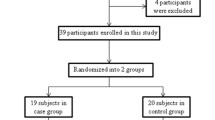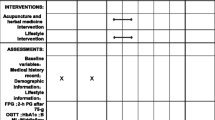Abstract
Objective
To investigate the effect of compound laser acupuncture-moxibustion on blood glucose, fasting insulin and blood lipids levels in type 2 diabetes mellitus (T2DM) rats.
Methods
Forty male Wistar rats were randomly divided into 4 groups, including the normal group, model control group, laser group and sham laser group (n=10 per group). The rats in the normal group were fed with a standard diet. Rats in other groups were fed with a high-sugar and high-fat diet for 4 weeks, then intraperitoneally injected with 1% streptozotocin to induce T2DM model. The laser group was irradiated by 10.6 µm and 650 nm compound laser on bilateral Pishu (BL 20), Shenshu (BL 23) and Sanyinjiao (SP 6) for 5 min, 6 times a week for 5 weeks. The sham laser group received the same treatment as the laser group, but without laser output. The model control group and normal group were not treated. Blood glucose levels were measured before and after 1, 2, 3, 4 and 5 weeks of treatment. The serum levels of fasting insulin, total cholesterol (TC), triglyceride (TG), low-density lipoprotein (LDL), and high-density lipoprotein (HDL) were analyzed after the last treatment.
Results
The blood glucose levels in the model control group increased during the 5 weeks of treatment compared with the normal group (P<0.05), while those in the laser group were significantly lower than the model control group after weekly treatment (P<0.01 or P<0.05). After 1, 2 and 3 weeks of treatment, the blood glucose levels in the laser group decreased obviously compared with the sham laser group (P<0.01 or P<0.05). Compared with the normal group, the levels of fasting insulin, TC and LDL in the model control group notably increased (P<0.01 or P<0.05), while their levels in the laser group were significantly lower than the model control group after 5 weeks of treatment (P<0.05 or P<0.01). However, no statistically significant differences were observed in TG or HDL levels among the 4 groups (P>0.05).
Conclusion
The compound laser acupuncture-moxibustion of 10.6 µm and 650 nm had positive effects on the regulation of hyperglycemia and insulin resistance in T2DM rats, which may be a potential treatment for T2DM, and also provide an alternative to the traditional acupuncture and moxibustion therapy.
Similar content being viewed by others
References
Zimmet P, Alberti KG, Shaw J. Global and societal implications of the diabetes epidemic. Nature 2001;414:782–787.
Yang WY, Lu JM, Weng JP, Jia WP, Ji LN, Xiao JZ, et al. Prevalence of diabetes among men and women in China. N Engl J Med 2010;362:1090–1101.
Xu Y, Wang LM, He J, Bi YF, Li M, Wang TG, et al. Prevalence and control of diabetes in Chinese adults. JAMA 2013;310:948–958.
Xu H, Li X, Adams H, Kubena K, Guo S. Etiology of metabolic syndrome and dietary intervention. Int J Mol Sci 2018;20:E128.
El Kaissi S, Sherbeeni S. Pharmacological management of type 2 diabetes mellitus: an update. Curr Diabetes Rev 2011;7:392–405.
Yang D, Liang XC. Strategies and research progress of Chinese medicine in prevention and treatment of diabetic peripheral neuropathy. Chin J Integr Med 2018;24:794–800.
Shi M, Liu ZL, Zhu YB, Xu MY, Duan XY, Shi HM, et al. Effect of health education based on integrative therapy of Chinese and Western medicine for adult patients with type 2 diabetes mellitus: a randomized controlled study. Chin J Integr Med 2018;24:94–102.
Wei JP, Wang QH, Zheng HJ, Wei F. Research progress on non-drug treatment for blood glucose control of type 2 diabetes mellitus. Chin J Integr Med 2018;24:723–727.
Peplow PV. Topical issue: acu-obesity and diabetes. J Acupunct Meridian Stud 2016;9:107–108.
Seeley EJ, Chambers HF. Diabetic ketoacidosis precipitated by Staphylococcus aureus abscess and bacteremia due to acupuncture: case report and review of the literature. Clin Infect Dis 2006;43:6–8.
Xu J, Deng HP, Shen XY. Safety of moxibustion: a systematic review of case reports. Evid Based Complement Altern Med 2014;2014:783704.
Shen XY, Zhao L, Ding GH, Tan M, Gao JP, Wang LZ, et al. Effect of combined laser acupuncture on knee osteoarthritis: a pilot study. Lasers Med Sci 2009;24:129–136.
Shen XY, Ding GH, Deng HP, Wei JZ, Zhao L, Zhou Y, et al. Infrared radiation spectrum of acupuncture point on patients with coronary heart disease. Am J Chin Med 2008;36:211–218.
Whittaker P. Laser acupuncture: past, present, and future. Lasers Med Sci 2004;19:69–80.
Patil UA, Dhami LD. Overview of lasers. Indian J Plast Surg 2008;41(Suppl):S101–S113.
Makihara E, Makhara M, Masumi S. Evaluation of facial thermographic changes before and after low-level laser irradiation. Phto Hed Laser Surg 2005;23:191.
Zhao L, Shen XY, Cheng K, Deng HP, Ding GH, Tan M, et al. Validating a nonacupoint sham control for laser treatment of knee osteoarthritis. Photomed Laser Surg 2010;28:351–356.
Cornejo-Garrido J, Becerril-Chávez F, Carlín-Vargas G, Ordoñez-Rodríguez JM, Abrajan-González M del C, de la Cruz-Ramírez R, et al. Antihyperglycaemic effect of laser acupuncture treatment at BL20 in diabetic rats. Acupunct Med 2014;32:486–494.
Meyer-Hamme G, Friedemann T, Greten HJ, Plaetke R, Gerloff C, Schroeder S. ACUDIN-ACUpuncture and laser acupuncture for treatment of diabetic peripheral neuropathy: a randomized, placebo-controlled, partially double-blinded trial. BMC Neurol 2018;18:40.
Beckmann KH, Meyer-Hamme G, Schröder S. Low level laser therapy for the treatment of diabetic foot ulcers: a critical survey. Evid Based Complement Alternat Med 2014;2014:626127.
Chen J, Zhang YB, Sang CL. The establishment of the SD rat model of type 2 diabetes and related indicators. Prog Veterin Med (Chin) 2012;33:91–95.
Hu J, Miao Q, Duan SF. Effects of rhein on urinary protein excretion in type 2 diabetic model rats. Chin Pharm (Chin) 2014;25:2113–2116.
Li ZR, ed. Experimental acupuncturology. 2nd ed. Beijing: Press of Traditional Chinese Medicine;2007:242.
Liu LL, Zhao L, Cheng K, Deng HP, Guo MH, Wei JZ, et al. Examination of the cellular mechanisms of leukocyte elevation by 10.6 and 650 nm laser acupuncture-moxibustion. Lasers Med Sci 2019;34:263–271.
Peplow PV, Baxter GD. Electroacupuncture for control of blood glucose in diabetes: literature review. J Acupunct Meridian Stud 2012;5:1–10.
Kim TH, Choi TY, Shin BC, Lee MS. Moxibustion for managing type 2 diabetes mellitus: a systematic review. Chin J Integr Med 2011;17:575–579.
Xue N, Zhang JB, Xia ZX, Da NL. Effect and postoperative reactions of acupoint catgut embedding for prediabetes. Chin Acupunct Moxibust (Chin) 2017;37:586–590.
Zheng QY, Yang HS, Xiang RR, Du YY, Lu Q, Zhang YS, et al. Meta-analysis of acupuncture treatment for type 2 diabetes. Shanghai J Acupunct Moxibust (Chin) 2016;35:618–622.
Feng YY, Fang YC, Wang YQ, Hao YM. Acupoint therapy on diabetes mellitus and its common chronic complications: a review of its mechanisms. Bio Med Res Int 2018;2018:3128378.
Zhang HF, Deng HY, Zhao L, Chen K, Zhang HM, Deng HP. Data mining and analysis of acupuncture treatment for diabetes. Shanghai J Acupunct Moxibust (Chin) 2014;33:1173–1177.
Hu XG, Li R, Jia N, Tian HH, Ma YJ, Wang YY, et al. Electro-acupuncture on T2DM rats with points at different nerve segment. J Clin Acupunct Moxibust (Chin) 2017;33:57–60.
Xue T, Bai L, Chen S, Zhong C, Feng Y, Wang H, et al. Neural specificity of acupuncture stimulation from support vector machine classification analysis. Magn Reson Imaging 2011;29:943–950.
Tian HH, Cao BY, Li R, Ma YJ, Hu XG, Jia N, et al. Effects of electroacupuncture stimulation at different spinal segmental levels in a rat model of diabetes mellitus. Acupunct Med 2017;36:29–35.
Lui H, Hobbs L, Tope WD, Lee PK, Elmets C, Provost N, et al. Photodynamic therapy of multiple nonmelanoma skin cancers with verteporfin and red light-emitting diodes: two-year results evaluating tumor response and cosmetic outcomes. Arch Dermatol 2004;140:26–32.
Wang LZ, Wu F, Shen XY, Wang M. A comparative study of the therapeutic effect of combined laser and red light emitting diode acupoint irradiation on knee arthritis. Chin J Tradit Chin Med Pharm (Chin) 2010;25:217–220.
Huang XY, Zhang L, Sun J, Xu NG, Yi W. Acupuncture alters expression of insulin signaling related molecules and improves insulin resistance in OLETF rats. Evid Based Complement Altern Med 2016;2016:9651592.
Nelson AJ, Rochelau SK, Nicholls SJ. Managing dyslipidemia in type 2 diabetes. Endocrinol Metab Clin North Am 2018;47:153–173.
Li M, Zhang YZ. Modulation of gene expression in cholesterol-lowering effect of electroacupuncture at Fenglong acupoint (ST40): a cDNA microarray study. Int J Mol Med 2007;19:617–629.
Liu ML, Zhang Q, Jiang S, Liu M, Zhang GS, Yue ZH, et al. Warm-needling acupuncture and medicinal cake-separated moxibustion for hyperlipidemia: study protocol for a randomized controlled trial. Trials 2017;18:310.
Ye XF, Zhang HF. Influence of moxibustion temperatures on blood lipids, endothelin-1, and nitric oxide in hyperlipidemia patients. J Tradit Chin Med 2013;33:592–596.
Liang FX, Chen R, Nakagawa A, Nishizawa M, Tsuda S, Wang H, et al. Low-frequency electroacupuncture improves insulin sensitivity in obese diabetic mice through activation of SIRT1/PGC-1alpha in skeletal muscle. Evid Based Complement Alternat Med 2011;2011:735297.
Yeom M, Park J, Lee B, Lee HS, Park HJ, Won R, et al. Electroacupuncture ameliorates poloxamer 407-induced hyperlipidemia through suppressing hepatic SREBP-2 expression in rats. Life Sci 2018;203:20–26.
Acknowledgement
We thank our peer reviewers for their insightful comments to the manuscript.
Author information
Authors and Affiliations
Contributions
Li Y preformed the experiment and drafted the manuscript. Qian ZY operated the laser device. Cheng K and Zhao L directed the operation of the experiment. The experiment data were analyzed by Deng HP. The manuscript was revised by Shen XY. All authors read and approved the final manuscript.
Corresponding author
Additional information
Conflict of Interest
All the authors declared that they have no conflicts of interest to this work.
Supported by the Science Foundation of Shanghai Municipal Commission of Science and Technology (No. 19441901200) and the Three-Year Development Plan Project for Traditional Chinese Medicine of Shanghai Municipal Health Commission [No. ZY (2018-2020)-CCCX-2001-05]
Rights and permissions
About this article
Cite this article
Li, Y., Qian, Zy., Cheng, K. et al. Effect of Compound Laser Acupuncture-Moxibustion on Blood Glucose, Fasting Insulin and Blood Lipids Levels in Type 2 Diabetic Rats. Chin. J. Integr. Med. 26, 33–38 (2020). https://doi.org/10.1007/s11655-019-3084-9
Accepted:
Published:
Issue Date:
DOI: https://doi.org/10.1007/s11655-019-3084-9




